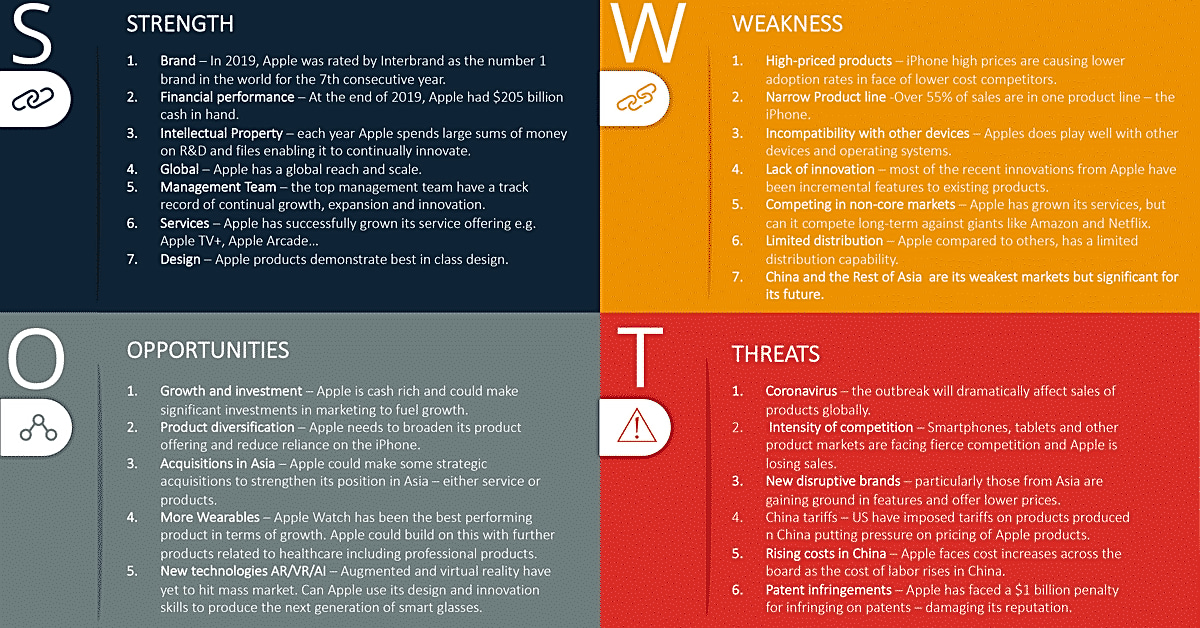In the world of technology and innovation, there are few companies that have made as big of an impact as Apple. With its iconic products, groundbreaking designs, and loyal fan base, Apple has become a household name and a leader in the tech industry. But what is it that sets Apple apart from its competitors? A key factor in understanding the company’s success lies in its SWOT analysis. In this article, we will take an in-depth look at Apple’s SWOT analysis, examining its strengths, weaknesses, opportunities, and threats. This analysis will provide valuable insights into how Apple has maintained its position as one of the top companies in the world, and how it plans to continue its success in the future. So sit back, grab your favorite Apple product, and join us as we delve into the world of Apple’s SWOT analysis.
To start, let’s define what a SWOT analysis is and why it is useful for understanding a company like Apple. SWOT stands for strengths, weaknesses, opportunities, and threats. It is a strategic planning tool that helps individuals and organizations identify their internal and external factors that can impact their success or failure.
For a company like Apple, which has a global presence and a wide range of products and services, conducting a SWOT analysis can provide valuable insights into its operations. It allows us to assess the company’s current position and make informed decisions about its future direction.
Now, let’s dive into each aspect of the SWOT analysis for Apple. First, let’s look at the strengths. Apple’s brand reputation is one of its biggest strengths. It has built a loyal customer base that is willing to pay a premium for its products. Additionally, the company’s innovative products and designs have set it apart from its competitors.
On the other hand, Apple also has weaknesses that need to be considered. One of its major weaknesses is its heavy dependence on the success of its iPhone sales. Any decline in iPhone sales could significantly impact the company’s overall performance.
Next, we have opportunities for Apple. The rise of emerging markets presents a significant opportunity for the company to expand its customer base and increase sales. Additionally, Apple has the potential to enter new markets or develop new products and services to further diversify its business.
Lastly, we have threats that could potentially harm Apple’s success. The tech industry is highly competitive, and new players are constantly entering the market. This poses a threat to Apple’s market share and profitability. Moreover, changes in consumer preferences and technological advancements could also pose a threat to the company’s success.
Now that we have covered each aspect of the SWOT analysis for Apple, let’s discuss how to conduct one. There are various templates and frameworks available for conducting a SWOT analysis, and it is essential to choose one that best fits your purpose. For business purposes, the most commonly used framework is the 2×2 matrix, which divides the factors into internal and external and positive and negative. For personal development, the SOAR framework (strengths, opportunities, aspirations, and results) is often used.
In conclusion, we have taken an in-depth look at Apple’s SWOT analysis and provided examples of its strengths, weaknesses, opportunities, and threats. We have also discussed different templates and frameworks that can be used for conducting a SWOT analysis. By applying this knowledge to their own situations, readers can gain a better understanding of their own company or organization and make well-informed decisions for future success.
What is a SWOT Analysis?
A SWOT analysis is a strategic planning tool that stands for strengths, weaknesses, opportunities, and threats. It involves analyzing these four factors to gain a comprehensive understanding of a company’s current position in the market and potential for growth or improvement. The strengths and weaknesses refer to internal factors, such as the company’s resources, capabilities, and limitations. The opportunities and threats refer to external factors, such as market trends, competition, and potential risks.
By conducting a SWOT analysis, companies can identify areas where they excel and areas where they may need to improve. It can also reveal potential opportunities for growth and potential threats that could impact the company’s success. This information can then be used to create strategies and make informed decisions for the future.
Opportunities for Apple
One of the biggest opportunities for Apple is its strong brand reputation and loyal customer base. With millions of devoted fans, Apple has a built-in market for any new products or services it introduces. The company can also leverage its brand recognition to expand into new markets and industries, such as healthcare and automotive.
Another opportunity for Apple is the growing demand for smart home technology. With its HomeKit platform and popular products like the HomePod and Apple TV, Apple is well-positioned to capitalize on this trend and potentially dominate the market.
Additionally, the increase in remote work and virtual learning due to the COVID-19 pandemic has created a need for reliable and high-quality devices. Apple’s strong reputation for quality and user-friendly products puts it in a prime position to meet this demand.
Lastly, Apple’s focus on sustainability presents a unique opportunity for the company. With consumers becoming more environmentally conscious, there is a growing demand for eco-friendly products. By continuing to prioritize sustainability in its operations and products, Apple can attract a larger customer base and differentiate itself from competitors.
Threats to Apple
Apple has established itself as a leader in the technology industry, but that does not mean the company is immune to threats. In fact, there are several potential threats that could impact Apple’s success in the future.
One of the biggest threats facing Apple is competition. As a company that is known for its innovative and high-quality products, there are many competitors who are constantly trying to catch up and surpass Apple’s success. Companies like Samsung and Huawei are constantly releasing new and advanced products that could potentially take market share away from Apple.
Another threat to Apple is the constant change in consumer preferences and trends. With the rise of new technologies and the increasing demand for more affordable options, Apple may struggle to keep up with the constantly evolving market.
Furthermore, government regulations and policies can also pose a threat to Apple. As a global company, Apple must navigate through different regulations and policies in each country it operates in. Changes in these regulations can impact the company’s operations and profitability.
Lastly, supply chain disruptions can also be a potential threat to Apple. As a company that relies heavily on its supply chain to produce its products, any disruptions or delays in the supply chain can significantly impact Apple’s ability to meet consumer demand and maintain its reputation for timely product releases.
Apple’s Weaknesses
Despite its immense success, Apple has faced its fair share of weaknesses over the years. One of the most prominent weaknesses is its heavy dependence on the iPhone for a large portion of its revenue. In fact, in 2019, iPhone sales accounted for over half of Apple’s total revenue.
This reliance on one product leaves Apple vulnerable to market fluctuations and shifts in consumer preferences. For example, when iPhone sales declined in 2018, it had a significant impact on Apple’s overall performance.
Additionally, Apple has faced criticism for its lack of innovation in recent years. Many argue that the company has become too focused on incremental improvements and has failed to introduce groundbreaking new products.
Another weakness for Apple is its high prices. While the company’s products are known for their quality and sleek design, they often come with a hefty price tag. This can limit their appeal to more price-conscious consumers and make it difficult for Apple to expand into emerging markets.
Furthermore, Apple has faced legal challenges and controversies surrounding its labor practices in overseas factories. This has damaged the company’s reputation and raised concerns about its ethical standards.
Overall, while Apple remains a dominant player in the tech industry, it is not without its weaknesses. These challenges highlight the importance of diversifying its product offerings and addressing any ethical concerns to maintain its success in the long run.
Apple’s Strengths
Apple’s strengths as a company are numerous and have contributed greatly to its success. One of its biggest strengths is its innovative and user-friendly products. Apple has consistently released groundbreaking products that revolutionize the tech industry, from the iPod to the iPhone to the Apple Watch. These products are not only technologically advanced, but also aesthetically pleasing and easy to use, making them highly desirable among consumers.
Another strength of Apple is its strong brand reputation. The company has established itself as a leader in the technology market, known for its high-quality products and sleek design. This has created a sense of trust and loyalty among customers, who are willing to pay a premium for Apple products.
Additionally, Apple’s ecosystem of products and services is a major strength. The seamless integration between Apple devices, software, and services creates a convenient and efficient user experience. This also leads to high customer retention rates and increased sales, as customers are more likely to stick with Apple for all their technological needs.
Lastly, Apple’s financial stability is a significant strength. With a market value of over $2 trillion, the company has strong financial resources that allow it to invest in research and development, marketing, and acquisitions. This gives Apple a competitive advantage in staying ahead of market trends and maintaining its position as a leader in the industry.
Templates and Frameworks for SWOT Analysis
A SWOT analysis is a useful tool for identifying a company’s strengths, weaknesses, opportunities, and threats. It can provide valuable insights and help guide decision making. However, conducting a SWOT analysis can be overwhelming without the right tools and frameworks. In this section, we will discuss some templates and frameworks that can be used for conducting a SWOT analysis.
1. The 2×2 Matrix
The 2×2 matrix is a simple but effective template for organizing the four elements of a SWOT analysis. It divides the analysis into four quadrants, with strengths and weaknesses on the top and opportunities and threats on the bottom. This visual representation allows for easy comparison and identification of relationships between the elements.
2. Porter’s Five Forces
Porter’s Five Forces is a popular framework for analyzing a company’s competitive environment. It looks at five different forces that can impact a company’s performance: supplier power, buyer power, competitive rivalry, threat of substitutes, and threat of new entrants. This framework can be useful in identifying external factors that may affect a company’s strengths, weaknesses, opportunities, and threats.
3. PEST Analysis
PEST analysis stands for Political, Economic, Social, and Technological factors. It is a framework for examining external factors that may impact a company’s operations. This can be helpful in identifying potential opportunities and threats that may arise from changes in the external environment.
4. SWOT/TOWS Matrix
The SWOT/TOWS matrix combines the traditional SWOT analysis with strategies for addressing each element. This framework can help turn weaknesses into strengths and threats into opportunities by identifying specific actions to take. It can also help in prioritizing which elements to focus on.
Conclusion
While there are many templates and frameworks available for conducting a SWOT analysis, it is important to choose the one that best fits your needs and the specific company being analyzed. These tools can help organize and guide the analysis process, leading to a more comprehensive and insightful understanding of the company’s strengths, weaknesses, opportunities, and threats.
Apple’s Strengths
Apple has many strengths that have contributed to its success as a company. One of its biggest strengths is its strong brand image and reputation. Apple is known for its innovative and high-quality products, which has created a loyal customer base and helped it stand out in a crowded market.
Another strength is its vertically integrated supply chain, which allows Apple to have more control over the production and delivery of its products. This has helped the company maintain high levels of quality and efficiency, as well as minimize costs.
Additionally, Apple has a strong financial position with a large cash reserve, allowing it to invest in research and development and make strategic acquisitions to stay ahead of the competition. The company also has a strong global presence, with a widespread distribution network and a strong online presence.
Finally, Apple’s strong leadership and talented workforce are crucial to its success. The company is known for its innovative and creative culture, and its employees are highly skilled and dedicated to pushing the boundaries of technology.
Apple’s Weaknesses
Apple’s success is undeniable, but like any company, it also has its weaknesses. Let’s take a closer look at some specific examples of Apple’s weaknesses as a company.
One of the main weaknesses of Apple is its heavy reliance on the iPhone for a majority of its revenue. While the iPhone has been a huge success for the company, it also puts them at risk if there is a decline in demand for the product. This was evident in 2018 when Apple faced a decline in iPhone sales and their stock prices dropped.
Another weakness of Apple is its high prices for products. While their premium pricing strategy has worked well for them so far, it also limits their potential market share. This is especially true in emerging markets where consumers may not be able to afford Apple’s products.
Additionally, Apple has faced criticism for its lack of innovation in recent years. Many argue that the company has been playing it safe and not taking enough risks with new products and features. This could potentially lead to a decline in customer interest and loyalty over time.
These are just a few examples of Apple’s weaknesses, but it’s important to note that every company has areas where they can improve. By acknowledging and addressing these weaknesses, Apple can continue to stay ahead of the game and maintain its position as one of the top companies in the world.
Apple’s Strengths
Apple’s strengths as a company are evident in various aspects of its operations. One of the main strengths of Apple is its strong brand recognition and loyal customer base. The company has a strong reputation for producing high-quality products that are reliable and user-friendly, which has helped it build a loyal following over the years.
Another strength of Apple is its innovative and cutting-edge technology. The company is known for constantly pushing the boundaries of technology and introducing new and revolutionary products to the market. This has helped Apple maintain its position as a leader in the tech industry.
Apple also has a strong financial position, with a market value of over $2 trillion. This allows the company to invest in research and development, acquire new technologies, and expand into new markets. Additionally, Apple has a strong supply chain and efficient distribution network, allowing it to quickly and effectively bring its products to consumers.
Lastly, Apple’s strong leadership and talented workforce contribute to its overall strengths as a company. The company is led by visionary CEO Tim Cook, who has successfully guided Apple through numerous challenges and maintained its position as one of the top companies in the world. The company also has a diverse and talented workforce, with employees from different backgrounds and expertise coming together to create innovative products.
Apple’s Weaknesses
While Apple is undoubtedly a successful and innovative company, it also has its fair share of weaknesses. One of the main weaknesses of Apple is its high product pricing. Apple’s products, including the iPhone, iPad, and Macbook, are typically priced higher than its competitors’ products. This pricing strategy may limit the company’s market share and appeal to a certain demographic of consumers who are willing to pay a premium for the brand.
Another weakness of Apple is its heavy dependence on the success of a few key products. The majority of Apple’s revenue comes from the sales of iPhones, making the company vulnerable to any potential decline in iPhone sales. This was evident in 2018 when Apple’s stock took a hit due to disappointing iPhone sales.
Additionally, Apple has faced criticism for its lack of innovation in recent years. While the company was once known for revolutionizing industries with products like the iPod and iPhone, it has since struggled to introduce new groundbreaking products. This has led to accusations that Apple is relying too heavily on its past successes and not investing enough in research and development.
Lastly, Apple has faced some backlash for its labor practices and supply chain management. The company has been accused of exploiting cheap labor in countries like China and using suppliers with poor working conditions. This has damaged Apple’s reputation and raised ethical concerns among consumers.
In conclusion, a SWOT analysis is a valuable tool for gaining insight into a company’s strengths, weaknesses, opportunities, and threats. By examining Apple’s SWOT analysis in detail, we have provided readers with a comprehensive understanding of how to conduct this type of analysis for any company. We hope this article has been informative and helpful in your own SWOT analysis endeavors.


